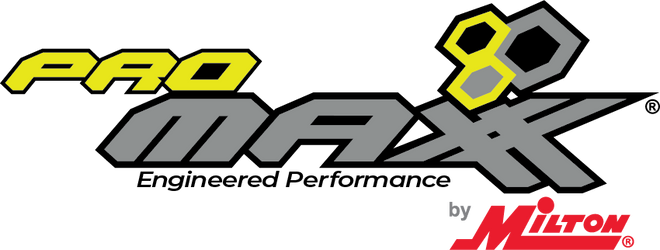Key Success Drivers for Ford Engine Repair Kits:
Fastest — Interchangeable bushings with fasteners and Extractorless™ capability.
Easiest — Simple to bolt on and make the repair.
Smallest — Easily fits behind the shock tower.
Most Precise — Engineered .001” accuracy, .0001” dead flat.
Versatile — Unique CNC machined thread repair kit available as well.
Patented and Made in U.S.A.
Check Out Video of Tech Using ProMAXX Tool Bolt Repair Kit & Cylinder Head Kit for On-the-Truck Repair
VIDEO
Tech uses Rocky II ProKit Plate and ProMAXX Tool Platinum Drill Bits to remove broken tap from botched exhaust manifold bolt repair on a 2015 Ford F-550 6.8L Triton. Once busted tap is gone, the Cylinder Head Repair Kit with black-oxide coated inserts restores the threads to better than Ford factory specifications.
Rocky II User Guide Info
FORD 4.6L 5.4L 6.8L DIESEL 6.0L 6.4L FIX MANIFOLD STUD - ROCKY II
Congratulations on your purchase of a ProMAXX® engineered performance device! Our tools have the highest quality and precision in the market delivering the most productive repair. All ProMAXX® tools are manufactured in the United States of America from American materials and craftsmanship. We proudly provide limited lifetime warranties and free unlimited technical support. Need help with the repair? Contact ProMAXX Technical Support @ 724-941-0941
Mount the ProPlate™ to the cylinder head using the included ProFasteners (PPF008375 or PPF008500) according to the enclosed cylinder head schematic. Torque ProFasteners to a minimum of 20 FT-LBS.
Insert the ProBushing™ into the ProPlate™. Then insert the corresponding ProDrill™ machine grade tooling bit (included) into an air-powered, angled-style drill. Using the drill depth gauge, machined into the ProPlate™, set the proper depth of the bit and mark if necessary. Apply one drop of ProLube™ (PPL001). AVOID USING PENETRATING OIL/SPRAY OR OTHER LUBRICANTS WHICH ELEVATE CUTTING EDGE TEMPERATURES CAUSING THE BIT TO BURN AND CEASE CUTTING.
Insert the prepared ProDrill™ into the mounted ProBushing™ by slowly and manually turning the drill chuck until the ProDrill™ slips into the bushing and makes contact with the surface of the damaged stud. (This will ensure the cutting edge is not damaged.) *Repeat this procedure for each sequential step in your application.
SET THE CUTTING EDGE: Important step to avoid drill bit breakage. While applying light pressure, activate your drill both on and off five times in one-second intervals (ten times if utilizing an air ratchet). This is the MOST CRITICAL step of this repair, creating precise alignment (a seat) for the tooling bit to stay on center and not follow the angular broken surface of the stud. Moreover, this step allows the surface of the stud to conform to the cutting edge of the bit, distributing the load evenly across the entire cutting edge, which is essential for cutting extremely hard surfaces and extending the life of the cutting tool.
After Step 4, run the drill continuously at proper RPM (see cutting speeds below). While the bit is turning, slightly extract the bit in and out of the damaged stud to “clean” or “excavate” cutting debris from the stud (commonly referred to as peck drilling). Repeat this step progressively, exerting more pressure until the drill reaches the marked depth.
Inserting ProTractor (PPT125): Remove the ProPlate™ and place the optional ProCutter (PPC007A) in the drill. Insert the protruding portion of the arbor into the drilled hole. Toggle the drill on and off five times to remove the burr and clean the tapped hole. With ProTractor (PPT125), place a mark approximately ¼” from the end and lightly hammer the ProTractor (PPT125) into the remnant, to the ¼” depth line. DO NOT INSERT THE PROTRACTOR ANY FURTHER THAN 1/4" depth line. Place the included slip-nut over the ProTractor™ and slide it up against the cylinder head. While holding the opposite end of the ProTractor™ and using a high-quality calibrated torque wrench, slowly and carefully apply torque, first in the clockwise direction, and then in the counterclockwise direction to loosen the damaged stud. Repeat this motion several times NOT EXCEEDING 75 IN-LBS OF TORQUE FOR THE PPT125 OR 150 IN-LBS FOR THE PPT188. If the damaged stud fails to release, STOP and remove the ProTractor™ and proceed to the next step.
Inserting ProTractor PPT188): using the larger (optional) ProDrill™ and corresponding ProBushing™, repeat steps 3-5 to prepare in using the larger extractor (PPT118).
NOTE: In the unlikely event an extractor fails or breaks, contact technical support at 724-941-0941 for recommendations and procedures. ProKits can also be upgraded to be an “Extractorless” repair: Repeating drilling instructions above and chasing threads clean with a machine-grade tap.
NOTE: ProMAXX® does not recommend tapered left-handed screw extractors as they have the potential to deform the remnant in the cylinder head increasing complexity of extraction. In addition, these extractors cannot be turned clockwise to unlock the damaged remnant. Approximate tooling cutting speeds (Under load): MIN: SSSC125/PLT125@500 RPM, SSSC188/PLT188@300, SSSC266/270/ PLT270@250.
NOTE: Some air ratchets may not generate sufficient RPM under load to be effective. See ProMAXX® ProRatchet PPR5260 or PowerDrill™ PPD2800 at www.promaxxtool.com for optimum efficiency and maximum productivity.
PROMAXX™ machine grade tooling is specially engineered to close tolerances of (+) .000” and (-) .001” and ground straight to ensure accurate and repeatable results in using your new device. Specify PROMAXX® genuine replacement parts and tooling for optimum performance and extended warranty coverage. Always use appropriate OSHA-approved safety glasses/goggles and protective gloves while using this device and performing this operation.
Rocky II User Guide PDF




